Lizards are found all over the globe, and some species have become invasive in areas they don’t belong. The pet trade is one of the main reasons a lizard finds its way out of its natural habitat. A lizard owner may release a lizard into the wild if they do not want to take care of the species anymore. In this article, you will learn about 10 invasive lizard species.
Lizards are some of the best pet reptiles that you can keep, and the wide diversity of species in the world means there is a type for everyone. Not every lizard is fit for captivity and some are harder to keep than others. In tropical states like Florida, lizards that are released can easily become invasive and cause problems in the area.
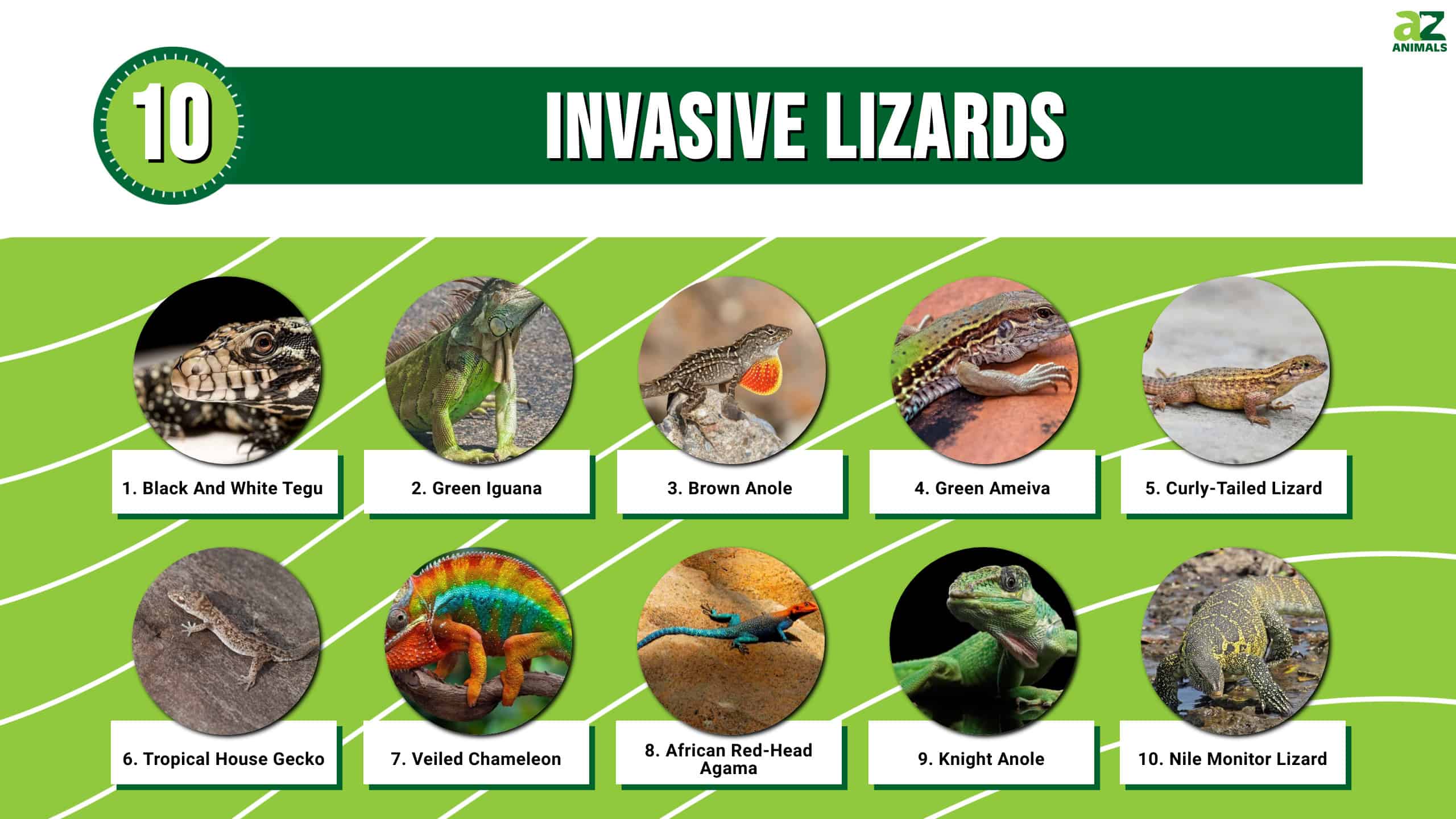
If you are planning on getting a lizard you should not underestimate how difficult they can be to keep as pets. Invasive lizards bring imbalance to local habitats and put lizards into areas they may not be fit to survive. Here are 10 species of lizards that are known for being invasive and interesting things you should know about each one.
1. Black And White Tegu
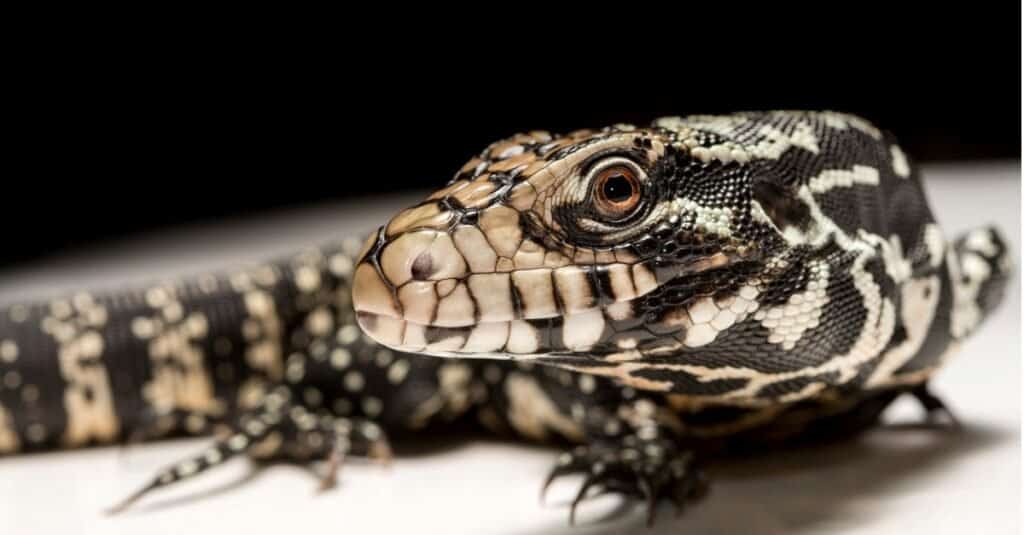
The black and white tegu is one of the best lizards to keep as a pet. It will even follow you around the house!
©iStock.com/Rafael Cutó
The black and white tegu (Salvator merianae) is the largest tegu species, and also makes a great pet for reptile lovers. These lizards are intelligent, able to be house trained, and can create a strong bond with a human. When born this species is green, but as they age they become black and white. They grow up to 4.5 feet, and their large size is why many are enticed to own them. Tegus are great pets for a large lizard, but the pet trade is one of the main causes of why this lizard is becoming invasive.
Since they are known as decent pets many people are eager to own them but are not prepared for how difficult they can be to keep. Black and white tegus are originally from Argentina, but have become an invasive species in areas within the U.S. Tegus are found in swamps, wetlands, and other flooded habitats, making it easy for them to survive in states like Florida.
2. Green Iguana
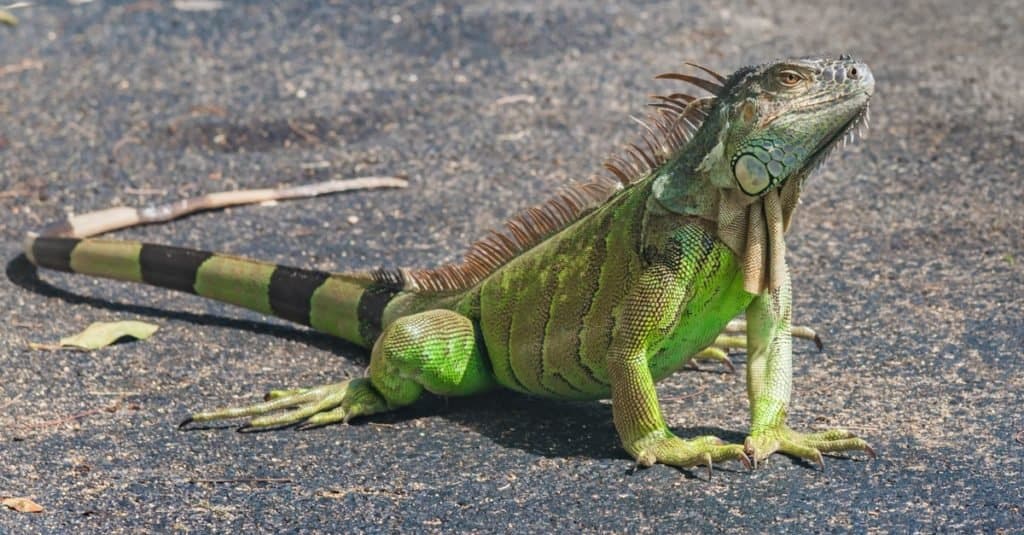
A large green iguana (Latin name Iguana iguana) defending its territory in the south Florida keys (Key West). Iguanas are not native to Florida and are considered an invasive species.
©David A Litman/Shutterstock.com
Native to South America, Central America, Mexico, and areas of the Caribbean islands, the green iguana is a large species that lives in tropical habitats. Green iguanas are the largest species of iguana in the world, growing up to 5 feet long. This lizard is often kept as a pet but has an aggressive nature.
Green iguanas are one of the hardest lizard species to keep as a pet and can regularly attack humans. They are capable of biting extremely hard and have a strong tail that can slash you by whipping it at you. While green iguanas are not dangerous if left alone, many that try to keep this lizard as a pet are not prepared for this challenge. Since they are problematic pets this species has been released into the wild and is invasive in places like Florida, Hawaii, and Texas.
3. Brown Anole

The skin under anoles is called a dewlap and is more present in male lizards.
©Natalia Kuzmina/Shutterstock.com
Originally from Cuba, Honduras, the Bahamas, and the Cayman Islands, the brown anole (Anolis sagrei) is a small species that is invasive to some areas. They are brown or gray, growing up to 9 inches long. This species lives in tropical and subtropical regions and has managed to spread to new areas due to the pet trade.
Here are some of the states brown anoles are invasive to in the United States:
- California
- Texas
- Florida
- Hawaii
- Georgia
- Louisiana
Brown Anoles are extremely aggressive and eat the eggs of other lizard species. They negatively affect the local ecosystem where they are invasive.
4. Green Ameiva
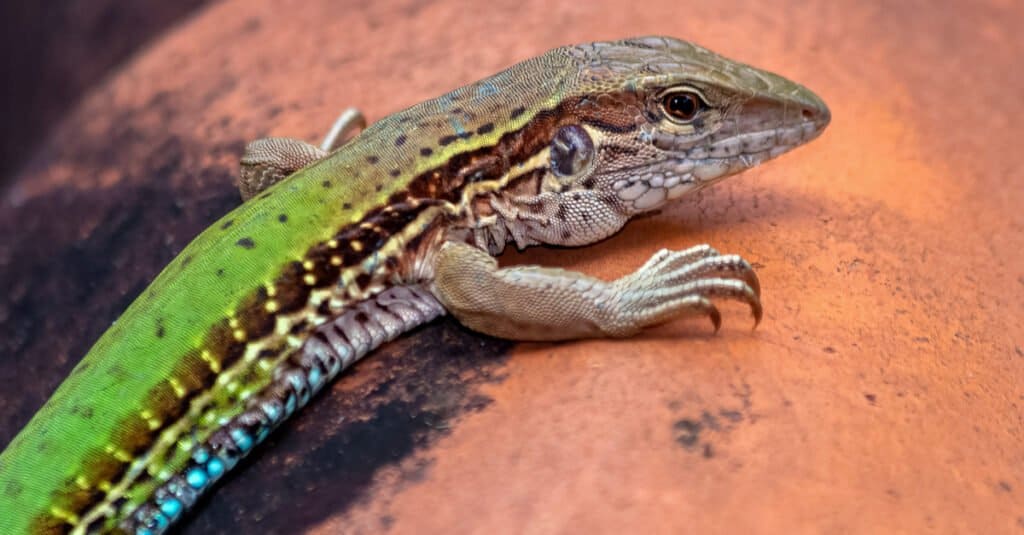
Green amievas are invasive in Florida.
©Fernando Calmon/Shutterstock.com
Like other invasive species, the green ameiva was introduced to North America due to the pet trade. They are also called the South American ground lizard since they are native to South and Central America. Forest habitats with an abundance of natural debris are where they prefer to live. This species has become invasive in Florida and is sometimes seen making tunnels under rocks and logs.
Large in size, green ameivas can grow up to 20 inches long and are covered in black specks. Their color is why people enjoy these lizards as pets since males will have bright green coloring. This species eats valuable insects like beetles, termites, and spiders that native lizards will feed on. They also occasionally eat other lizards, dwindling the population of native lizard species in areas they are invasive to.
5. Curly-Tailed Lizard

Curly-tailed lizards curl and uncurl their tail as a way to distract predators.
©chanicephoto/Shutterstock.com
The curly-tailed lizard is a species known for its curly tail, with around 29 different species existing. These lizards are originally from the Bahamas, Cuba, and the Cayman Islands; they are now found in Florida, becoming an invasive species. This lizard is an aggressive species and will hunt down native lizards and insects.
Curly-tailed lizards are easily identifiable because of their curly tails and are found in large numbers in Florida. Green or brown coloring is the most common, and sometimes both colors are found on this lizard. Curly-tailed lizards grow up to 11 inches and are occasionally kept as pets.
6. Tropical House Gecko
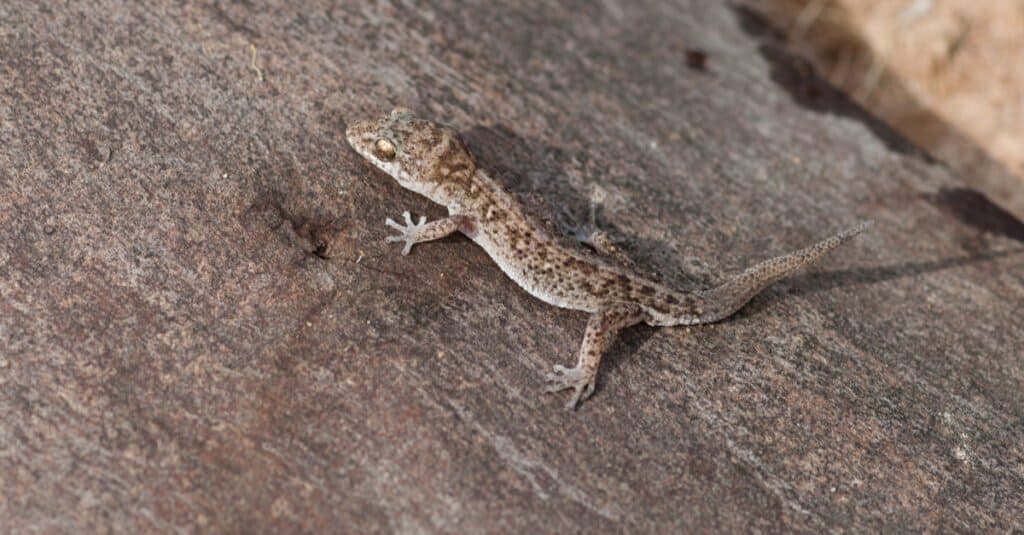
Geckos use light sources to hunt since they attract insects they feed on.
©DOME PRATUMTONG/Shutterstock.com
Tropical house geckos (Hemidactylus mabouia) are native to sub-Saharan Africa but are a common invasive species in the U.S., and other countries. This lizard is nocturnal and can be found in forests, tropical savannas, and shrubland habitats, but is usually found in suburban areas. At night this species will make peeping and rapid squeaking noises.
Occasionally this gecko can be found in homes, and for some is a sign of good luck. They feed on small insects, doing most of their hunting at night.
7. Veiled Chameleon

Panther chameleons do well in captivity. It is second to only the veiled chameleon as the species of chameleon most bred in captivity.
©Kurit afshen/Shutterstock.com
Veiled chameleons (Chamaeleo calyptratus) are native to Yemen and Saudi Arabia but are found in other places as well. Due to their escaping or being released, they have become an invasive species in Hawaii and Florida. These tropical habitats make perfect homes. Veiled chameleons live in woodlands, gardens, and areas with mildly dense trees. Out of their native areas, this species brings an imbalance to the ecosystem by eating native insects, frogs, and lizards.
Like other chameleons, the veiled chameleon is able to change colors in an instant. Chameleons will change their color based on temperature, mood changes, and to communicate with other lizards. This species is not the best pet, which causes some people to release them into the wild.
8. African Red-Head Agama

Agamas are named after their red heads,
but also have deep blue bodies.©Matt Jeppson/Shutterstock.com
A hard-to-miss species, the African red-headed Agama is originally from Africa as its name suggests. This bright species can now be found in Florida, as it’s a growing invasive species. The pet trade is one of the main causes of why this lizard is now invasive. They have been able to survive due to the warm climate and lack of natural predators.
Orange heads, tails, and blue bodies give this species a colorful look. Females are not as colorful, but males are painted in bright colors to make it easier to attract a mate. Rainbow agama is another name this species goes by, and they are extremely popular in the pet trade. While they can make good pets, they are a huge commitment as they can live more than 20 years.
9. Knight Anole
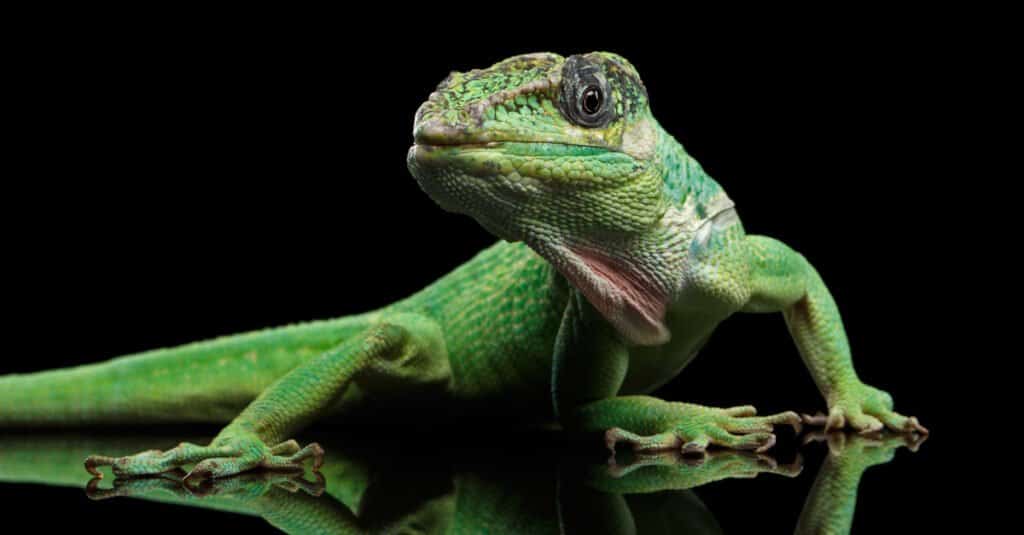
Knight anoles feed on insects and also smaller lizards
©Seregraff/Shutterstock.com
The knight’s anole (Anolis equestris) is native to Cuba, but like other lizard species have managed to become invasive in other areas. Florida’s climate is suitable for many animals, and why animals like the knights anole have found a home in the state. These lizards grow to around 13 to 20 inches and have green coloring with white stripes running down their side. They are able to change colors and spend most of their time in trees.
Insects are what this species usually eats, but they sometimes eat fruits. Knight anoles have large appetites and will feed on local lizards in areas they are invasive to. Anole lizards are common around the world, and also are a common invasive lizard.
10. Nile Monitor Lizard

Nile monitor swimming through vegetated water.
©Dave Montreuil/Shutterstock.com
Monitor lizards are one of the coolest looking lizards, but they often do not make great pets. Nile monitors (Varanus niloticus) have become an invasive species in areas like Florida since they can be such hard pets to keep. They are large and can grow to be up to 8 feet long. They have bright yellow and black patterns covering their body, with dinosaur-like features. Nile monitors were originally from Africa, but have managed to find their way around the world due to the pet trade.
This lizard is the largest in Africa and is found around the Nile river. They are aggressive lizards and should only be kept by expert reptile keepers. Sharp teeth and large size make them successful predators, hunting rodents, small reptiles, and birds in the areas they live. Most monitor lizards are not suited for the pet lifestyle, but that does not stop people from trying to keep them. Only knowledgeable reptile owners who make a strong commitment to keeping this lizard will be able to care for them effectively.
Summary Of The 10 Invasive Lizards
| # | Invasive Lizard | Found In | Native To |
|---|---|---|---|
| 1 | Black And White Tegu | Florida | Argentina |
| 2 | Green Iguana | Florida, Hawaii, Texas | South America, Central America, Mexico, and areas of the Caribbean islands |
| 3 | Brown Anole | California, Texas, Florida, Hawaii, Georgia, Louisiana | Cuba, Honduras, the Bahamas, and the Cayman Islands |
| 4 | Green Ameiva | Florida | South and Central America |
| 5 | Curly-Tailed Lizard | Florida | The Bahamas, Cuba, and the Cayman Islands |
| 6 | Tropical House Gecko | United States | Sub-saharan Africa |
| 7 | Veiled Chameleon | Hawaii and Florida | Yemen and Saudi Arabia |
| 8 | African Red-Head Agama | Florida | Africa |
| 9 | Knight Anole | Florida | Cuba |
| 10 | Nile Monitor Lizard | Florida | Africa |
The photo featured at the top of this post is © iStock.com/passion4nature
Thank you for reading! Have some feedback for us? Contact the AZ Animals editorial team.






